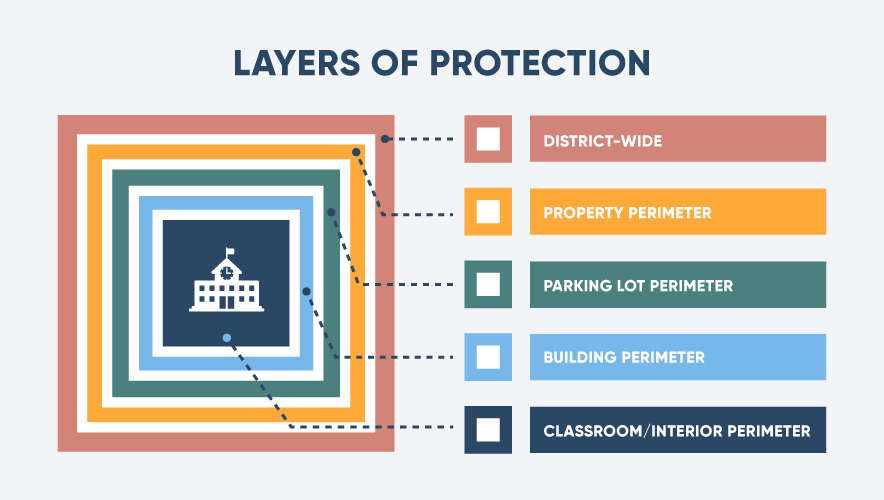Strengthening Schools: A Look at K-12 Security Layers and Emergency Preparedness
In an era of evolving threats and unforeseen challenges, ensuring the safety of students, staff, and faculty in K-12 schools is of paramount importance. Security in educational institutions goes beyond traditional measures, encompassing a multilayered, multifactor approach that combines technology, personnel training, and emergency preparedness.
While the school building itself is static, everything inside is variable. Students constantly move through hallways, whether for passing periods, walking to restrooms, or myriad other reasons. The attention of staff and students alike is divided among competing priorities. That means emergency preparedness requires a considerable amount of practice (muscle memory, if you will) for everyone to behave as needed during emergencies.
To get there, schools must focus on the big picture. This includes comprehensive planning and districtwide standards—leveraging updated infrastructure that includes open architecture solutions and systems integration—to deliver security as a series of perimeters.
Security Perimeters
According to the Partner Alliance for Safer Schools (PASS), an independent group dedicated to improving school safety, there are five layers of protection to consider: districtwide, property perimeter, parking lot perimeter, building perimeter, and classroom or interior perimeter.

At the outermost edge are districtwide security measures and comprehensive policies to guide individual school implementation. The districtwide layer involves leadership and coordination for developing, adopting, and updating school safety processes, plans, technologies, and procedures. Given the wide range of emergencies that can arise and affect safety for one or more individuals (medical, hazmat, inclement weather, and so on), the response plans must be comprehensive.
The property perimeter starts at the school property boundary and extends to the parking lot, including playgrounds, sports fields, and other facilities used after school hours. It’s where the physical security of a school begins and the most outwardly visible security deterrents are implemented.
The parking perimeter—defined as the areas where staff, students, and visitors park vehicles or use transportation by bus and other means—is where schools experience the most safety issues, including falls, car accidents, dangerous driving, theft, vandalism, and assaults.
The building perimeter includes the grounds adjacent to the exterior of a school building and its exterior doors and windows. Security solutions range from simple to complex, especially for middle or high schools with multiple buildings and open campuses. Key safety and security functions encompass all areas where people enter and exit the building.
The classroom or interior perimeter consists of all areas inside a school’s buildings, including classrooms, gymnasiums, cafeterias, libraries, and media centers. It’s the last layer of defense against external threats and usually the first order of protection against internal threats to life safety.
Looking to the Future: Electronic Access Control
Solutions that enable situational awareness help tremendously with keeping staff and students safer and campuses more secure. Still, more consistent partitioning at schools is needed, such as vestibules for screening visitors (including parents and contractors), to ensure they are authorized to access corridors and other approved destinations within the school. There is also a greater need for stronger doors and reinforced glazing at key ground-level entrance points in campus buildings.
Several locking solutions on the market can enhance door safety on school campuses. One that’s increasingly gaining momentum is electronic access control (EAC). One everyday use case is a student’s need to visit a restroom. With an EAC solution, a teacher could issue a credentialed, temporary hall pass card to a student that allows him or her to leave the room and then relocks the door. Upon return, the student simply presents the card credential at the lock to get back in. Similarly, other staff members can issue temporary credentials to students returning to class from other appointments or late arrivals.
A broader example of schoolwide EAC shows how one independent school district in Texas put access control readers at every classroom door. In the event of a lockdown, shelter in place, or evacuation order—each of which requires a different response—specialized software drives the behavior of those devices.
Furthermore, district officials optimized the solution so any teacher could seek refuge for staff and students in any classroom and not be limited to their own classroom. The system also allows authorized personnel to lock individual doors on a campus or the entire district with the push of a button.
Like the one in Texas, other school districts are implementing access control in K-12 interior spaces, due to the lower cost-per-opening of a lock. Wireless solutions have also been a major driver because installation is easier and the hardware is more affordable. EAC also helps control after-hours access to activity areas like auditoriums for performing arts events, gymnasiums, and ball fields for sports.
Electronic locks are effective in many other school interior locations as well. To reduce vandalism and theft issues, for example, installing EAC solutions on locker room doors and places like auditoriums, which are only occupied periodically, has proven to deter theft and other unwanted activities that plague these hard-to-monitor areas. Doors can be programmed to lock and unlock strictly based on scheduled classes like physical education or practices, rehearsals, and events.
Cameras are highly effective for monitoring public areas like corridors and entrances, making them more common in districts. Tied into video management systems, they go hand in hand with electronic access controlled doors to create a unified, extra layer of security.
Combined, they provide first responders with greater situational awareness during an active event. Preauthorized credentials issued to law enforcement and response teams allow them to gain entry quickly through controlled openings. The accompanying video helps correlate where tactical teams are in relation to those openings, a perpetrator, and people sheltering in place.
Approaches to Emergency Preparedness
While not every district or school will—or should—use the same template, there are global strategies that K-12 security professionals can use to reduce risk. These strategies should include the core principles of prevention, mitigation, preparedness, response, and recovery within the security framework. The core capabilities and planning measures that underpin these principles include a layered approach to overall access control implementations, building on solid processes and procedures, and upgrading to and integrating modernized solutions.
To support a safe K-12 environment effectively, security professionals need to pay special attention to security guidance. It needs to have breadth and depth, and it needs to be communicated so it drives widespread adoption.
Policies should be applied identically across all public buildings within the school district. Strong written policies can ensure that people know what to do in an emergency and can support security professionals in their efforts to drive compliance with essential safeguards and accountability. To be effective, policies centered on preparedness and prevention, as well as response and recovery, need to be woven into the fabric of the school community.
Regular drills and simulations are invaluable for preparing students and staff for emergencies. Conducting fire drills, lockdown drills, and other emergency response exercises ensures that individuals understand and can execute predefined protocols. Establishing crisis intervention teams within schools ensures that designated individuals are equipped to handle specific crises and de-escalate potential threats. These teams play a pivotal role in fostering a safe and supportive school environment.
Establishing strong partnerships with local law enforcement, fire departments, and emergency medical services during simulations and beyond is vital. Collaboration enables a swift and coordinated response in the event of an emergency, maximizing the effectiveness of emergency preparedness plans.
Engaging parents and the broader community in school security efforts is crucial. Open communication channels, community forums, and workshops contribute to a shared responsibility for creating a safe learning environment. Empowering students to be active participants in their own safety fosters a sense of responsibility. Programs that educate students on recognizing and reporting potential threats contribute to the overall security culture.
Technology can help only so much because safety is everyone’s responsibility, and the evolving nature of threats necessitates continuous adaptation and improvement in security measures. A multilayered approach to security in K-12 schools, encompassing technological advancements, human elements, and robust emergency preparedness, is essential for creating a secure and conducive learning environment. Educational institutions can improve emergency responses by integrating these layers effectively and engaging the entire school community in the process.
Whether it’s students remembering not to leave exterior doors propped open, teachers knowing the appropriate steps to take during different types of emergencies, or school district administrators managing communications with parents and emergency responders—everyone has a role to play to ensure everyone inside school buildings stays safe.
Guy Grace has dedicated more than three decades to ensuring the safety of K-12 environments by holding security and emergency preparedness director positions. Currently, he is the K-12 National Safety Program manager at ASSA ABLOY Opening Solutions and serves as the vice chairman of Partner Alliance for Safer Schools (PASS).

















